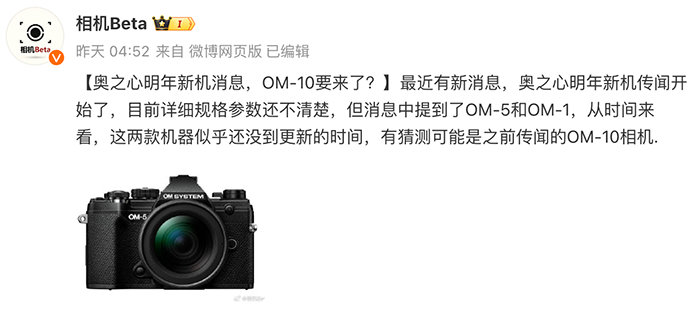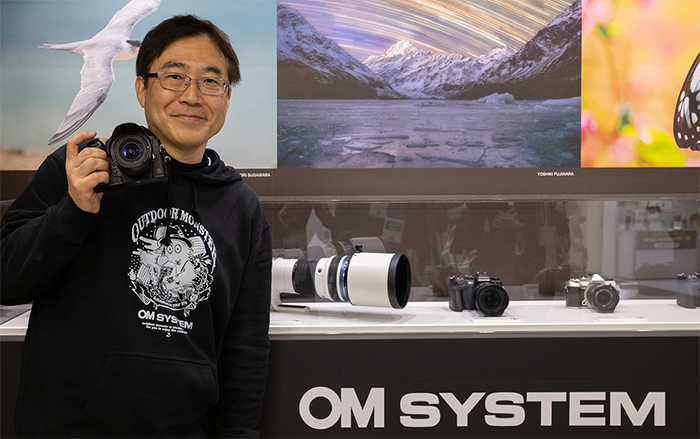Olympus E-M1 Mark II and Nauticam NA-EM1 II by Phil Rudin

Olympus E-M1 Mark II and Nauticam NA-EM1 II
by Phil Rudin
The Olympus E-M1 Mark II has been selected as camera of the year for 2016 by a number well respected reviewing sites and magazines who put far more time into pixel peeping than I do. So up front I would just like to begin by saying that I think the E-M1 Mark II is the best Micro43 camera available and that anyone interested in underwater photography should take a close look at this camera and the excellent Nauticam NA-EM1II housing system.
The E-M1 Mark II completes the hugely successful Olympus OMD series and is a brilliant successor to the E-M1 platform released in 2013. The E-M1 Mark II is the “Pro” end of the OMD lineup and the new Olympus agship camera. It directly targets Pros and high end enthusiasts who don’t mind shelling out $1999.00 USD (now $1799.99 at Amazon USA and others) for a highly capable and very compact camera body.
The Mark II is a compelling choice for DSLR users considering a move to a mirrorless camera system and for Olympus users wishing to move up from the Olympus E-M5 and E-M10 series cameras.

Olympus E-M1 Mark II
This is the rst in a series of reviews I will do during the year on Micro43 equipment. What sets the E-M1 Mark II apart from the still very competitive E-M1 is a virtual laundry list of upgrades to the original. Olympus has completely outdone itself with a total redesign of the entire camera from top to bottom. This is no incremental upgrade to stimulate new sales, instead the Mark II has exceeded all expectation for both the Olympus faithful and the seasoned reviewing community.
Some of the key upgrades include a new 20MP live MOS sensor, Cinema (DCI) and UHD 4K (237Mbps) video, Micro-HDMI, an insanely weather-sealed and temperature resistant body, a new hybrid 121 point auto focus system, high-res electronic view nder, fully articulating 3” LCD screen, 60 FPS burst rate, with mechanical frame rates up to 10 frames per second (18FPS in continuous AF), a new TruePic VIII processor for blazing speed and buffering, Dual card slots for SD/SDHC/and SDXC (top slot for high speed cards), the best in-body image stabilization system made with up to 6.5 stops (6.5 stops with the new Olympus 12-100mm F/4 IS and 300mm F/4 IS lenses with 5.5 stops for native and most non-native lenses), USB-3 (type-C), 50MP high-res shot mode, a larger new battery that extends battery life to new levels for a mirrorless cameras, a refined menu interface, the ridiculous number of manual controls Olympus users have come to expect and much more.
The E-M1 Mark II is the most programmable camera on the planet with a wide array of buttons, levers and dials for every possible programming need. With the new E-M1 Mark II Olympus has also introduced the excellent new M.Zuiko Digital ED 12-100mm F/4 Pro zoom lens which has turned out to be an incredible travel lens. The new lens follows in the footsteps of the 12-40mm F/2.8 Digital ED PRO introduced with the E-M1 camera and the rst of the Olympus M.Zuiko PRO line of lenses. Olympus also introduced the new powerful FL- 900R external ash which has a 58m guide number, the new STF-8 macro ash set, the new HLD-9 battery grip and the PT-EP14 underwater housing.
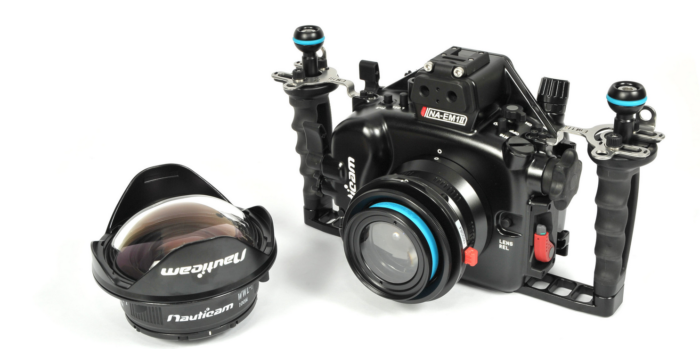
The E-M1 Mark II body is as expensive as many current mid to high end DSLR’s. While many DSLR users in the underwater photography community are still be turned off by mirrorless cameras they fully grasp the merits of APS-C over full frame sensor cameras for underwater use. These smaller cameras require smaller housings, smaller lenses, smaller ports and smaller extensions which all add up to a more cost effective and travel friendly system.
Smaller sensors also increase depth of field and provide better corner sharpness with many wide angle lenses. If you consider the many qualities of the E-M1 Mark II along with the total system cost you have a very compelling case for the Olympus E-M1 Mark II and Nauticam NA-EM1 II combination as your next underwater photo system. The overall build quality and nish of the E-M1 II all magnesium body is comparable to any of the top $2000.00 plus PRO cameras bodies. The body has exceptional dust, moisture and freeze resistance along with a larger grip to accommodate the new larger battery compartment. The E-M1 II while a bit larger than the E-M1(574g v. 497g) is much easier to hold and operate both in and out of the Nauticam housing. Olympus has also reduced the ash sync speed from the 1/320sec found on the E-M1 to 1/250sec. I have seen a number of rants on the internet over the past three years about poor video implementation on the E-M1. This has all changed with the release of the new E-M1 II and I will be addressing the video features of the camera in a review later in the year. If video is your main interest then you should also be looking at the soon to be released Panasonic GH-5 (at $1997.99 USD) to compare the features that may be important for your video needs.
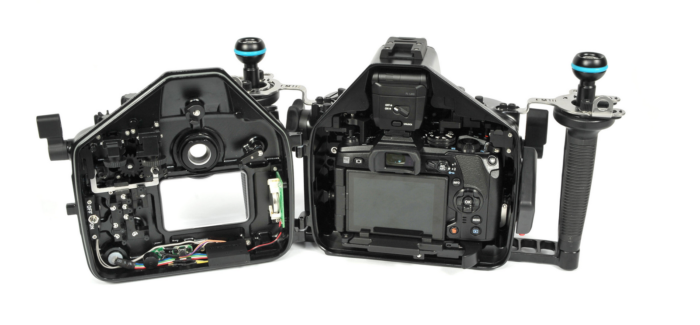
Olympus excellent 5-axis in- body image stabilization system is the best on-sensor stabilization made and it works with any lens including legacy lenses regardless of the type of lens mount. The latest IBIS allows an industry leading 5.5 stops of light with an impressive 6.5 stops using the new Olympus 12-100mm F/4 IS and 300mm F/4 IS Pro lenses. The operational speed of the new E-M1 II is impressive with excellent startup speed and DSLR level shot to shot speeds.
While the E-M1 II can shoot 60 FPS with the electronic shutter and focus locked A more useful speed for U/W photographers would be the continuos autofocus normal mode using the mechanical shutter at 10 FPS. This speed would be more than adequate for fast moving Sail sh attacking a bait-ball.
If you move over to the electronic shutter you get autofocus and autoexposure at up to 18 FPS with less blackout in the EVF all while shooting RAW plus jpeg. if you want. Without the sleep mode turned on or the EVF turned off I have exceeded 1000 images on a single battery charge above water.
The number of M43 lens choices for both land and underwater use is excellent with very high quality wide angle zooms, primes and macro choices. The E-M1 II also has outstanding overall image quality and high dynamic range surpassing the E-M1 by a noticeable margin with DXO marks in the APS-C sensor range.
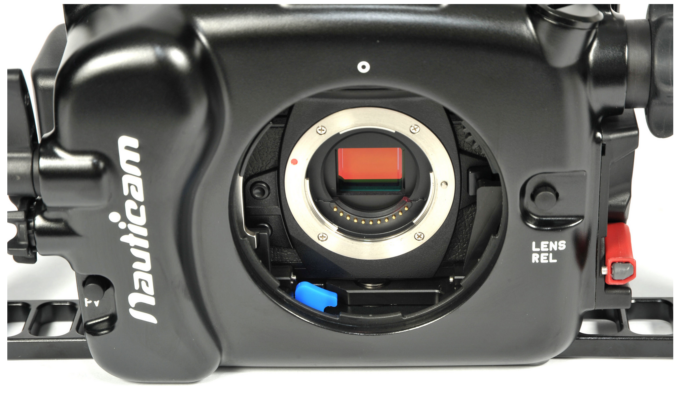
Nauticam NA-EM1 II
The new NA-EM1 II housing lives up to Nauticam’s commitment to “Innovation Underwater” by re ning and improving on its original NA- EM1 housing. Nauticam has done away with the EM-5/EM5II removable Flex-tray and replaced it with an integrated handle system which ts ush to the bottom much like the DSLR housings. The shutter release and the focus lock can now be accessed with the thumb and fore nger using vertical control triggers rather than the push controls found on many housings. This allows you to hold the housing by the right hand grip and control both shutter and focus locking while having a firm grip on the housing. I found this feature alone to be worth the cost of upgrading from the E-M5/5II. The signature Nauticam handles are also reinforced by laser cut stainless steel brackets making the system more sturdy and stable when adding extra lighting. The left hand side of the housing has a rubberized zoom/focus knob which is quite smooth in use and very easy to control while holding the left hand grip.
The iconic port locking system that is a hallmark of Nauticam housings incorporates the signature red port locking lever which is synonymous with Nauticam DSLR housings. The lock is on the left hand side of the housing and continues to be both the easiest and most secure port locking system I have ever used. One thing the Nauticam NA- EM1II housing does not share with their DSLR housings is the removable back plate and locking system.
The NA-EM1 II housing has a clam shell back hinged to the left hand side of the housing it uses the same rotary locking system found on all Nauticam mirrorless camera housing. The new housing features a locking camera tray which keeps the camera secure and properly aligned while opening the back plate. The locking tray is secured to the bottom of the camera via a tripod screw and helps to protect the LCD screen. To slide the camera tray into place inside the housing lift the on/off control then move the tray locking lever to the unlocked position. Once the camera is installed the lever is moved back into the locked position. After installing the camera lower the on/off control lever over the top of on/off switch and always keep the ccamera amera turned off during this process. Once you cycle through this process a few times removal of the camera becomes very easy. I like this on/off con guration because I know the switch is aligned prior to entering the water. The NA-EM1 II housing also has two ber optic bulkheads for triggering up to four optically triggered strobes. Strobes like the Inon Z-240, Inon S-2000, Inon D-2000, Sea & Sea YS-D2, YS-01, Retra Flash and more will all re using these sync ports. Strobes can be red in TTL or manually without the use of electronic sync cables which are more prone to ooding. Optically red strobes can be triggered in two ways. First the Olympus FL-LM3 ash that ships with the camera can be used for both TTL and manual ring.
The Olympus FL-LM3 ash uses power from the cameras battery which will slowly deplete the battery during extended use in TTL or manual mode. In manual mode you can reduce the power output by minus three EV’s of light to help reduce battery drain and the external strobes will still fire. The NA-EM1II housing has an on/off control switch if you have forgotten to turn on the FL-LM3 ash before your dive or you want to quickly turn off your strobes for an A/V light image.
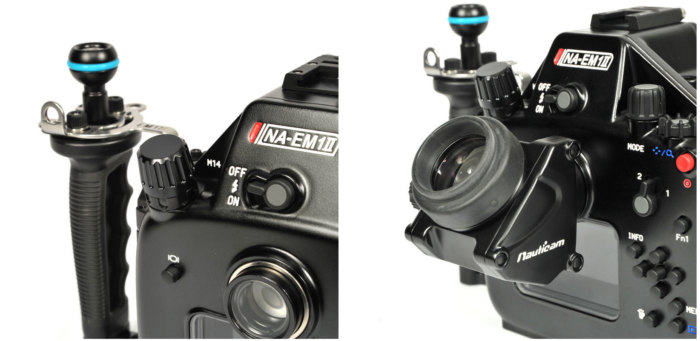
Nauticam also offers the Mini Flash Trigger (26306) for Olympus which is compatible with NA-EM1II, NA-EM1 and NA-EM5II housings (use the LED assemble marked E-M5 II with the NA-E-M1II housing and do not replace the wedge insert). The upside to Nauticam’s $220.00 USD ash trigger is that it uses two CR2450 batteries which will run a very long time with the supper small LED lights. The ash trigger will also work at blazing speeds easily keeping up with the 10 frames per second mechanical shutter speed and perhaps even 18 FPS, not yet tested. Since strobes like the Inon Z-240 set to lower manual powers can also recycle in the 6 to 10 FPS range with quality batteries the possibilities for high speed ash photography, think the Sail sh are now possible underwater using ber optics. The Nauticam ash trigger for Olympus does not work in TTL which may prevent some from wanting to make the investment.
After using a Nauticam manual ash trigger with a Sony A7R II underwater system for a year and a half I will never be without one for my Olympus E-M1 II system. Going forward I intend to carry the FL-LM3 as a backup when I travel. If you want to hardwire your strobes the NA-EM1II housing has M14 & M16 openings for Nikonos and other bulkhead con gurations. Like the Nauticam E-M1 housing the new NA-EM1II housing accommodates an accessory optical view nder. But unlike the older NA- E-M1 housing you do not need to purchase an accessory EVF window to mount the view nder. I nitpicked Nauticam about this issue from the release of the NA-EM5 housing and recently sold my EM5 window and 45 degree nder to a friend who could not justify buying a new one. Nauticam now offers optional 45 degree and 180 degree optical nders in a new con guration to t all new mirrorless ICL housings. They have the same diopter adjustment as the DSLR nders and same superior optical quality. I use the 45 degree nder for all my macro and super macro work especially with high power closeup lenses like the Nauticam CMC-1.
After years of use I have become spoilt and would not want to go back to the pickup under which ships with the housing. For those who have never used a 45 degree nder expect a learning curve of 10 to 20 dives. For fast moving subjects and wide angle scenes the 180 degree nder will be the better choice if you are not using very low angles.
The Nauticam NA-EM1 housing was the rst to be released with the optional Nauticam vacuum and leak detection electronic installed. Nauticam has updated the optional vacuum value to version II which was introduced in November at the DEMA show in Las Vegas. This optional new valve II has a red push button to release the vacuum when you remove the cap. The M14 opening on the rear door of the housing has been tilted about 20-25 degrees towards the rear of the housing making it much easier to mount the vacuum pump onto the smaller valve II without needing to move clamps, arms and other accessories.
The NA-EM1II housing has a new blue vacuum reset button at the bottom of the port mount which allows you to reset the vacuum system without opening the rear of the housing. Once you have turned the switch on inside the housing and secured the housing back it does not need to be reopened for reset. This means that if you want to change lenses between dives you can release the vacuum by depressing the valve button, remove the port, reinstall lenses and ports then reset the vacuum system. Once you have install a new lens & port you can draw the vacuum without ever needing to open the housing back. With housings like the NA- EM1II and NA-A7II several lenses like the Olympus 7-14mm zoom need to be mounted from the front of the housing due to the lens & gear diameter. Having the reset button at the port opening will expedite this process, kudos Nauticam for making life a little easer. My review of the original vacuum system is in back issue #76 at UWPMAG.com. One of the major problems with designing a housing for such a small camera is being able to place the control buttons and dials far enough apart so that you have ngertip control even while wearing heavy gloves. The button control layout for the NA-EM1II housing is quite good allowing me to effortlessly reach all of the controls without having to look at which buttons I am about to push.
The only button on the camera that cannot be accessed is the DOF button on the front of the camera. Because of the large number of function buttons and endless programability of the E-M1II DOF can be easily assigned to a number of other control buttons if needed. Once you have customized and mastered the button layout you will not nd yourself turning the camera off or hitting the video button by mistake. I am still assigning functions but nd it is a breeze to reach the controls once you have dived the system a few times. If you have ever used a housing where the control buttons were placed directly over the ones on the camera you will appreciate the time that has been spent ergonomically designing the function buttons for this housing.
All of the current Nauticam N85 ports for Olympus and Panasonic lenses will t the new housing along with the some of outstanding ZEN Underwater ports. Olympus old DSLR style threaded ports for the Olympus DSLR lenses are also supported with an optional Nauticam port adapter. New port solutions for lenses like the Olympus 8mm Fisheye, Olympus 7-14mm zoom and 30mm macro are also offered. At $1900.00 USD the Nauticam NA-EM1II housing is a bargain when you consider that it includes the handles, ball-heads for mounting support arms and the Vacuum electronics plus all of the other excellent features.
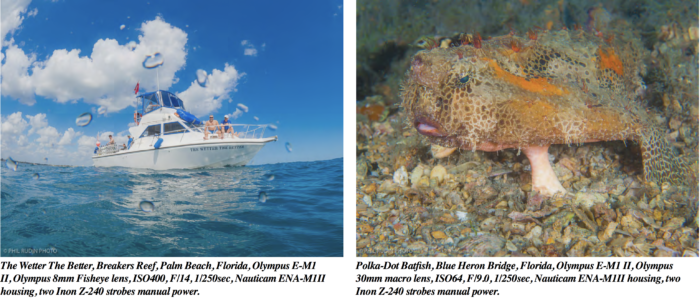
(Click on image to enlarge)
In the field
For this review I thought I would shoot macro with the new Olympus 30mm F/3.5 macro lens using the Nauticam macro port 45. This new $300.00 macro lens has great image quality for the price and reaches 1.25:1 (beyond life size) at the quite close minimum focus distance of 9.5mm (3.74”). I generally nd lenses in the 30mm (60mm 35 equivalent) range great for larger closeup/macro subjects and sh portraits. The high magni cation and narrow lens to subject distance make using add-on closeup lenses dif cult and yield very little extra magni cation.
I will also be using the Olympus 8mm sheye with a ZEN Underwater 170mm optical glass dome port. This is the port I currently have access to and I will also be testing the Nauticam N85 140mm optical glass sheye port with the 8mm sheye and a 17mm extension for a review later in the year. I currently use two 10” X 2.4” Nauticam oat arms and two 8” double ball arms to mount my lighting. I recommend that everyone try some type of otation with every housing to offset the weight of the system. When you are on holiday doing multiple dives over several days or weeks the added of otation will de nitely improve your ability to steady your system saving stress to your hands, wrists and forearms. I use two Inon Z-240 type four strobes red with ber optics cords for most of my work. At times I will also use the SAGA optical snoot with one or two Inon Z-240 strobes mounted off camera. Unlike most of my reviews I had a very limited amount of time with this new system before my review deadline. So this rst eld section is based on only three dives.

(Click on image to enlarge)
The E-M1 I has the best auto focus system of any Olympus camera I have used to date. It in fact is equal to or exceeds any of the other cameras. I have tested for UWPMAG. The focus locking trigger allowed for fast and accurate auto focus. I was most impressed with the pin point accuracy of the AF system when I moved the focus points to the extreme corners of the frame. I also nd the super screen very easy to control from the OK arrow pad. One push of the OK button opens the super screen allowing access to a larger number of functions that can be changed using the arrow buttons. I also use the arrow buttons to quickly move the ve point AF array I have selected around within the frame.
The large, bright and highly detailed EVF allowed me to see ne details as they came into sharp focus and it is easy to enlarge images to check for ne detail. The aperture and shutter speed dials are also very intuitive and easy to use without moving your eye away from the EVF. Both lenses worked well with the ports I was using. The 30mm macro lacks a bit of the speed higher cost lenses offer but image quality is excellent for an under $300.00 macro lens. The 8mm Fisheye was extremely fast and accurate on the E-M1 II and paired with the 170mm ZEN Underwater port image quality was impressive.
If you are looking for an extremely high quality camera and housing system in a relatively small package you should checkout the E-M1 Mark II and Nauticam NA-EM1 II housing at your local retailer.
Special thanks to Nauticam USA and ZEN Underwater for assistance with some of the equipment used for this review. Also thanks to Walker’s Dive Charters and the wonderful crew of “The Wetter The Better” for a great day of diving in the Palm Beaches.
Phil Rudin
Issue 95/44
www.uwpmag.com
